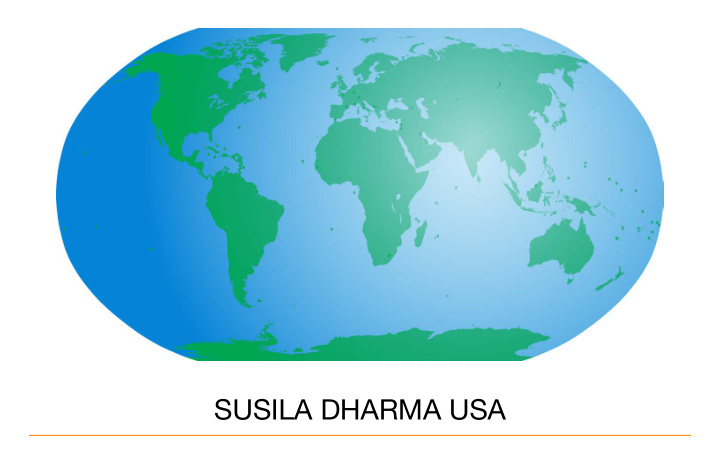



SuSila Dharma uSa
Borneo / Kalimantan
Borneo / Kalimantan
the ForeSt iS a living entity…
BioDiverSity S cientiStS are now Studying what indigenous peoples have long understood—the extent and complexity of the life of forests. t he treeS and other plants, the fungi, the bugs, the snakes, the lizards and the mammals, do not live in isolation, they communicate with one another and act together in harmony, as the cells of a living body. t he e arth iS alive …
the trageDy oF DeForeStation d eforeStation deStroyS the habitat of myriad plants and animals and the home and livelihood of all of the indigenous peoples. i t alSo deStroyS the incomprehensibly com- plex living systems that we call “forest.”
ForeSt loSS in Borneo iS unpreceDenteD 85% of lowland rainforeSt has been cut down since 1975
Driven By gloBal DemanD For… • Tropical Hardwoods • Pulp (second cut) • Palm Oil • Petroleum • Gold • Farmland
the people oF Borneo • P anang • d ayak • J avaneSe • M alay • c hineSe the Dayak longhouses along the Kahayan river taken in tumbang anoi village (c. 1894)
the people oF Borneo t he deStruction of Borneo’s forests has eliminated the tra- ditional way of life of the native peoples who have been forced into a cash economy that their culture never prepared them for. t he PoPulation of the iSland has increased dramatically because of immigration, mostly poor people following the promise of farmland and the lure of gold.
SuSila Dharma in Kalimantan yayaSan permaKultur Kalimantan (ypK) Bina cita utama (Bcu) yayaSan tamBuhaK Sinta (ytS) yayaSan uSaha mulia (yum) Borneo int’l FootBall acaDemy (BiFa)
yayaSan tamBuhaK Sinta (ytS)
FireS, mineS, chainSawS anD BullDozerS a round 1970, the deMand for forest products and palm oil, coupled with the Indonesian government’s transmigration program that moved a huge population of landless farmers from Java and Bali to the island, meant that the ownership and control of land became serious cause of confmict. The native people’s of Borneo had no governmental or bureaucratic structures in place, which meant they had no deeds or other “legal” claim to the lands they had traditionally used.
ancient wayS meet the gloBal economy ytS began working in the seven villages of Bukit Batu in 2009. Using “Participatory Rural Appraisal” techniques, they assisted the commu- nities in the sub-district to make a village development plan , and started providing a village development fund to help villagers develop liveli- hoods in the new economy.
ancient wayS meet the gloBal economy f iSh are a traditional Source of Protein in the diet of the peoples of Borneo/Kalimantan; but environmental destruction has drastically reduced the natural supply.
worlD in tranSition ytS haS been develoPing a training program in the art of freshwater fjsh farming, focusing on fjsh hatcheries to seed this local industry. Fish farming has the potential to be a signifjcant source of income and to increase protein in local diets. t he w orld changeS and people must, inevita- bly change, too. YTS, working with the people of Kalimantan, is creating a way that this transition can happen—retaining traditional ways where possible and adjusting to economic and political forces that originate in distant lands.
Education for a Sustainable Ecological Changing World Livelihood Waste Management yayaSan uSaha mulia (yum) —Kalimantan
Banturung Sanitation project (yum)
SuStainaBle livelihooDS (yum)
eDucation For a changing worlD (yum)
yayaSan permaKultur Kalimantan (ypK)
what iS permaculture? P erMakultur k aliMantan f oundation (yPk) pro- vides permaculture educa- tion and training in Central Kalimantan to improve land management, increase com- munity resilience and food security, support sustainable livelihoods and help to con- serve the natural environ- ment in the region.
what iS permaculture? P erMaculture is the harmoni- ous integration of landscape and people—providing food, energy, shelter, and other material and non-material human needs in a sustainable way. P erMaculture includeS agriculture, water management, energy, archi- tecture, forestry, waste manage- ment, animal systems, aquaculture, appropriate technology, economics and community development.
what iS permaculture? t hiS SySteM of agricultural methods and social design prin- ciples consciously mimics natu- ral ecosystems, integrating land, resources, people and the envi- ronment through mutually bene- fjcial synergies – imitating the no waste, closed loop systems seen in diverse natural systems.
what iS permaculture? t he word permaculture originally referred to “permanent agriculture,” but was expanded to stand also for “permanent culture,” because society is integral to any sustain- able system that includes human beings.
Bina cita utama
Bina cita utama b ina c ita u taMa (bcu) School is an innovative educational commu- nity in the Palangka Raya district of Central Kalimantan, with a high-quality, human-centered learning environment. i t iS a Model school that can be replicated throughout the province. BCU seeks to nurture individuality, self-worth, a sense of humanity, and to educate children to become adults who will make a positive contribution to the development of their communities and the world.
Bina cita utama
Borneo international FootBall acaDemy t he b orneo f ootball a cadeMy brings together children from the diverse ethnic and racial groups of Borneo around the game of Football (soccer in the USA). b ut the PrograM addreSSeS the whole child, including help with homework, English lan- guage classes, awareness of the Bornean environment, and a Health and Nutrition pro- gramme, which SD USA helps to fund.
BiFa health anD nutrition programme
SuSila Dharma uSa
the content oF SurrenDer iS action —muhammad Subuh Sumohadiwidjojo
Recommend
More recommend